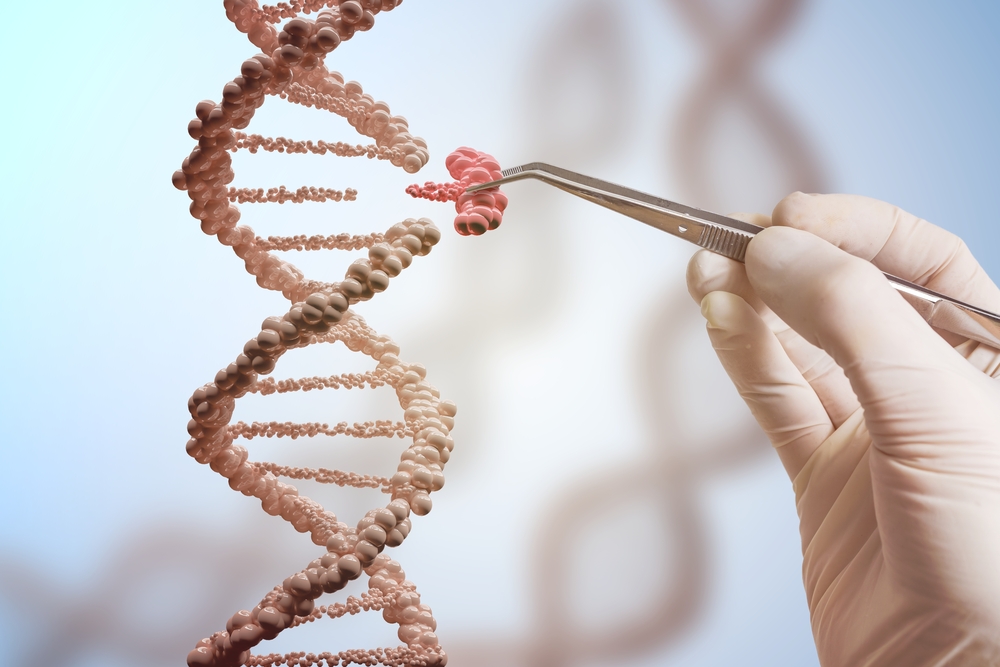CRISPR-Cas9 Corrects Common DMD-causing Mutation in Mice and Human Cells

Restoring a functional dystrophin gene using the genome editing tool CRISPR-Cas9 corrected a common mutation behind Duchenne muscular dystrophy (DMD), exon 44 deletion, in mice and human cells, a study shows.
The same research lab had already proved the technique was successful for correcting in a simple and efficient way a range of DMD-causing mutations. The new findings represent another significant step toward a possible clinical application of CRISPR-Cas9 as a therapy for DMD, researchers say.
The study “CRISPR-Cas9 corrects Duchenne muscular dystrophy exon 44 deletion mutations in mice and human cells” was published in the journal Science Advances.
The most common types of mutations that cause DMD are those that result in the deletion of exon 44 of the dystrophin (DMD) gene.
An exon is a portion of the gene that gives instructions for the production, or codes, for a piece of the protein that corresponds to that gene. In most DMD-causing mutations, a deletion in one exon at the DMD gene changes the way the gene is read by the cell machinery, generating a faulty dystrophin protein.
Building on recent positive results using CRISPR-based approaches for DMD, the lab of professor Eric Olson at the University of Texas Southwestern Medical Center and his colleagues developed a similar strategy for correcting the exon 44 deletion mutations underlying the disease.
Interested in Muscular Dystrophy News research? Sign up for our forums and join the conversation!
As this kind of mutation can be corrected in around 12% of the patients by doing small modifications to the neighboring exons, researchers employed CRISPR-Cas9 to genetically edit the exons surrounding exon 44 and repair the DMD gene.
CRISPR-Cas9 is a recently discovered system that can be used to cut or add small pieces of DNA to a specific location in the genome, a process known as gene editing.
The CRISPR-Cas9 system is being highly acclaimed by the scientific community because it is faster and more accurate than other existing gene-editing tools.
For it to work, two key components are required: a guide RNA and a DNA-cutting enzyme called Cas9.
The guide RNA is a small piece of RNA (a genetic messenger copied from DNA) that contains a short sequence able to bind to the target region in the genome. It also binds to Cas9 enzyme, guiding it to the targeted location.
Once at this specific region, the Cas9 enzyme cuts DNA. Then the cell’s own DNA repair machinery allows the addition or deletion of pieces of genetic material or the replacement of segments with a custom DNA sequence.
In this case, researchers designed several guide RNAs meant to direct Cas9 to, and introduce changes at, exons 43 and 45, which flank the defective exon 44.
Using a viral vector commonly used for gene therapy, called AAV9, researchers introduced the genetic material coding for Cas9 and guide RNAs inside cells.
The technique proved successful in correcting the DMD gene and restoring dystrophin protein in heart muscle cells (cardiomyocytes) derived from stem cells of DMD patients carrying the exon 44 deletion.
To show that this type of treatment could be delivered to a living organism, researchers genetically modified mice to make them carry an exon 44 deletion akin to the one present in patients. These mice were administered with the CRISPR-Cas9 by injections into the leg’s muscle.
The results showed that three weeks after the injections, the DMD gene has been corrected and the production of dystrophin protein was re-established in both the heart and skeletal muscle, including muscles of the fore and hind limbs, and the chest (diaphragm) of mice.
In addition, the study also tested different dosages and guide RNA sequences for optimizing the gene correction protocol. Those tests showed that the proportion of Cas9 to guide RNA strongly influences the efficiency of the method.
The same laboratory had shown previously that this and other CRISPR tools could correct the genetic defects behind DMD. Given their promising efforts, the team was awarded a grant from Parent Project Muscular Dystrophy to continue its studies and identify possible risks associated with the method in a clinical setting.
The project leader, Olson, with the support of Cure Duchenne, also has launched a company to develop CRISPR/Cas9 therapy for DMD.
The mouse model of exon 44 deletion developed for this study, combined with the optimized guide RNA and AAV vectors for delivery “should facilitate progress toward long-term correction of dystrophin mutations in mice as a prelude to possible clinical translation, ” the report states.






